Are you headed to Jordan and looking for the perfect 7 day Jordan itinerary? You’ve come to the right place, as here we will explain everything you need to know to have an amazing 7 day trip to Jordan.
Jordan is a landlocked country in the Middle East that features some of the most stunning desert landscapes and archaeological sites that you will ever see.
Known for the ancient historical site of Petra, as well as the Dead Sea, the Wadi Rum desert, and Roman ruins galore, Jordan is an action packed holiday destination that more and more people are starting to discover each year. You’ll soon see why when you embark on this 7 day Jordan itinerary. You’re gonna love it!
I’ve done this exact road trip and spent countless hours exploring the places you will see on this trip in order to give you the most up-to-date and useful information for planning your own trip. You can trust you’re getting the best info here.
Note: this article contains affiliate links, which means that should you purchase something or get a quote through them I may make a small commission at no additional cost to you. This helps keep the site running with up to date information. I do not represent World Nomads, Booking.com, GetYourGuide, or Rentalcars.com. This is information only and not a recommendation to buy the product mentioned in this article.
Summary of the Main Sites You Will See
We will go through all the sites in detail in the itinerary below, but let’s start with an overview of the main sites you are going to visit.
- Petra
- The Dead Sea
- Wadi Mujib Biosphere Reserve
- Wadi Rum Protected Area
- Amman
- Jerash
Additional optional sites:
- Memorial Church of Moses
- The Babtismal Site of Jesus Christ
- Dana Biosphere Reserve
- Museum of the Lowest Place on Earth
Places you will miss:
- Aqaba and the Red Sea
- Irbid
There is a lot to see and do in Jordan, and if you only have seven days, the optional sites listed above will be really tough to fit in. But it can be done by an ambitious traveler.
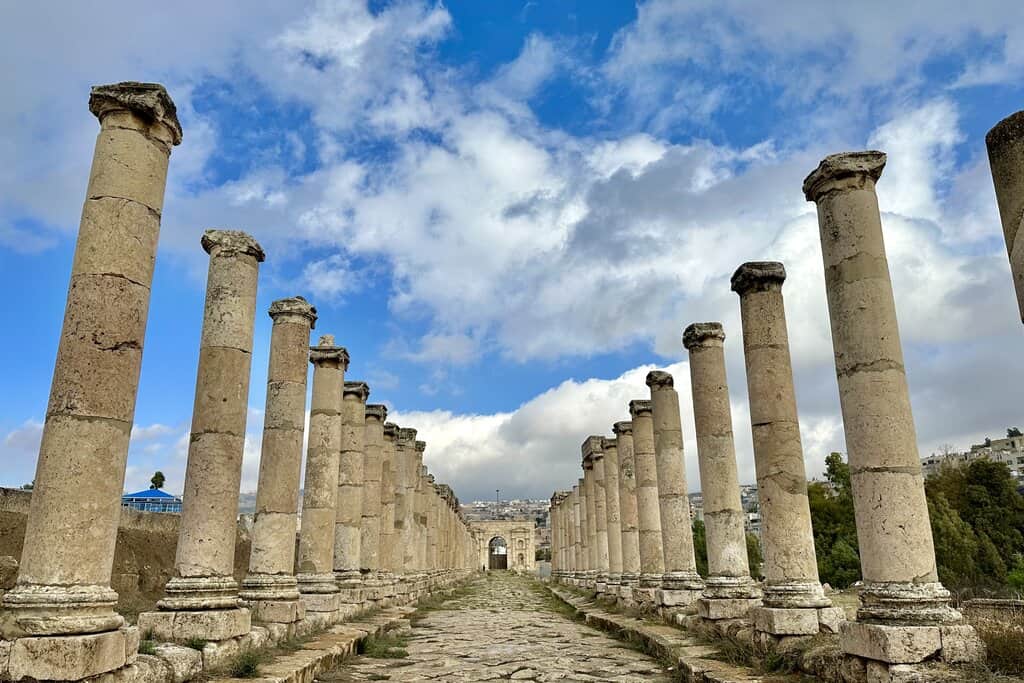
7 Day Jordan Itinerary – Important Information
How to get around Jordan
It is highly recommended that you complete this 7 day Jordan itinerary as a road trip in a rental car. Driving in Jordan is safe and modern, much like driving in a western country (with the exception of children walking in the road!).
You can find a great deal on a rental car with Rentalcars.com from the Amman Airport using the search bar below.
Where the trip starts and ends
This itinerary starts and ends in Amman, the capital or Jordan. So the assumption is that you’ll be flying into Amman the day or night before starting this road trip.
The airport is about 20 minutes south of the city and has direct flights to many international destinations, though not a whole lot of long haul flights. Unless you’re coming from New York you’ll likely have to layover in London or Istanbul or somewhere else in Europe or the Middle East.
Landscape of Jordan
The landscape of Jordan is entirely an arid desert. It features the lowest elevation on earth (at the Dead Sea) as well as surprisingly high sandstone mountains. The countryside is characterized by rolling hills mostly devoid of trees. There is very little flat land in the country. It has a lot of similarities to southern Utah and the Australian Outback.
Total mileage covered
Jordan is a small country so this road trip only actually covers about 750 km (470 miles). There is only limited driving on what could be considered a motorway though, so you’ll be driving about 12-13 hours total. It’s a nice, relaxing road trip without having to be in the car for too long.
Money
Jordan’s currency is the Jordanian Dinar. It’s pegged to the US Dollar at a rate of 1.41, meaning that 1 JOD = 1.41 USD at all times no matter what. You will need cash in Jordan so be sure to get some at the airport. This post will either list the prices in Jordanian Dinar, US Dollars, or both.
Expected total cost
How much you spend on this Jordan trip is totally up to you. Accommodation in Jordan can be really cheap – like $10-20 a night cheap. Even the nicest hotels in Amman are far cheaper than a roach-infested motel in New York or London. If you’re spending more than $200 per night on accommodation you’re staying at really nice places.
Accommodation options also vary by location. Wadi Musa (where Petra is) is pretty cheap and there are not a whole lot of hotels over $150 per night. In Wadi Rum, however, there are tons of luxury accommodations as well as dozens of super budget accommodations. So when it comes to hotels over 7 days, you can spend anywhere from $200-$2000.
Rental cars are affordable in Jordan. If you book in advance you should be able to find a standard sedan for about $200 for seven days. Gas prices are about $4-5 per gallon (varies with oil prices though so don’t quote me on that).
Food prices can be really cheap or quite expensive. Locals will often try to overcharge you, so be sure to discuss price first if there is no menu. On average you should be able to get a nice meal anywhere for $10-15 USD. In Amman, you can find amazing food for much cheaper though.
So in summary, the amount this trip will cost you is totally dependent on your travel style.
Weather in Jordan
Jordan is the desert, so it’s usually hot and dry. Summers can be brutally hot, but not as bad as Las Vegas or Dubai. Still, hiking around in 100-degree (38 C) can be dangerous. June through August is characterized by high temperatures and little to no rain.
Winter is usually pretty mild, but can be chilly and rainy. Temperatures are often in the 50s to mid 60s (10 – 18 C), but vary greatly depending on elevation. Fall and spring are more pleasant and offer comfortable temperatures for outdoor activities.
Best time of year to set out on this itinerary
The best time of year for a road trip around Jordan is April-May or mid September to early November. This is based pretty much solely on weather. These will also be the busiest times, but luckily Jordan isn’t an overcrowded tourist destination just yet, so you shouldn’t have to worry about things being too busy.
Jordan Pass
Before departing for your trip you will need to purchase a Jordan Pass. Technically you don’t need to, but you absolutely should. It will make your trip so much smoother.
Jordan Pass is like a museum pass for all the archaeological and historical sites and museums in Jordan. It also includes your Jordan entry visa, which alone is $60. Jordan pass comes with three options – aligned to the three options for visiting Petra – a one day, two day, or three day Petra entry. All other sites are one day entries. The Jordan Pass is 70 JOD ($99), 75 JOD ($106), or 80 JOD ($113), respectively.
Even if you see nothing but Petra on your trip to Jordan it saves you money to have the Jordan Pass. On this itinerary you will use it for Petra, Jerash, Wadi Rum, and the Amman Citadel. It also includes dozens of additional sites that you likely will not have time to see unless you spend longer than 7 days in Jordan.
You must purchase your Jordan Pass ahead of time and carry a printout or a PDF on your phone to gain entry to the sites. It expires after two weeks from when you enter Jordan at immigration. So if you’re planning on spending extra time in the country, do your sightseeing first.
Where to stay
Each day of the itinerary is described in great detail in the following section and each overnight stop includes recommendations for where to stay.
Travel insurance
When visiting Jordan you’ll absolutely want to have a quality travel insurance policy. We use World Nomads when we travel internationally. World Nomads provides coverage to travelers in over 100 countries. You can find a great policy on World Nomads by using the link below.
Here’s a look at the entire road trip on Google Maps:
The Ultimate 7 Day Jordan Itinerary
Alright, now let’s get into the specifics about the itinerary. We won’t go into great detail about any of the sites here, but you’ll get a summary that will give you the ammo you need to plan your trip. Get ready to explore the best that Jordan has to offer!
Day 1: Jerash and the Dead Sea
Let’s assume you’ve flown into Amman the day or night before and spent the night somewhere in or around Amman. We will save Amman for the end of the trip and head straight to Jerash, about 45 minutes north of the city.
Jerash
Jerash is a small city home to about 50,000 inhabitants. But it’s most known for having one of the best preserved ancient Roman cities in the world. The archaeological site of Jerash contains marvelous Roman ruins, including multiple completely intact amphitheaters, and is one of the most visited sites in Jordan.
Plan to arrive by 9 AM and spend about 3 hours at the archaeological site, exploring the many walkways, theaters, and hidden rooms. There is no need to hire a guide, but should you want one there will be tons of locals offering their guide services to you. Some might tell you that guides are required but they absolutely are not.
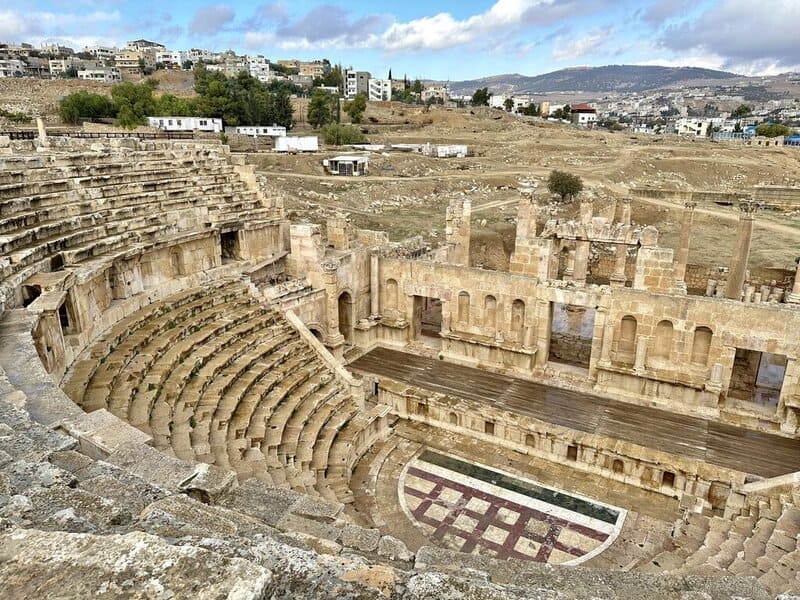
Also be wary of anyone who offers to take your photo. They will take a few photos then demand an exorbitant tip of like $14. Don’t give your phone/camera to anyone unless you’re sure they are another tourist.
The city of Jerash outside the archeological site is not worth seeing, so when you’re satisfied with your walk around the ancient Roman ruins grab a quick lunch before leaving Jerash. There are a few places to eat near the main entrance. Don’t count on finding a restaurant between Jerash and the Dead Sea. It’s surprisingly difficult. So eat before getting back on the road.
The Dead Sea
It’s about a 90 minute drive from Jerash to the resort area of the Dead Sea with no stops. The main hotel/resort area is at the northeast corner of the Dead Sea. Assuming you’re staying there, check into your hotel as soon as you can so you can take a dip in the sea before the beaches close.
The private Dead Sea beaches are staffed by lifeguards (even though you literally cannot drown in it) and close at dusk. So depending on the time of year you visit, they may close early.
Floating in the Dead Sea is an experience like none other. I’ve dedicated an entire post that goes into everything there is to know about visiting the Dead Sea so be sure to read that too. In summary, the water is so salty that it’s more dense than the human body, so you float. Just don’t stay in the water much more than 10 minutes at a time, as the salt isn’t good for your skin.
If you’re staying at one of the resorts, you’ll likely not be leaving the property the rest of the night. The resorts have multiple restaurants and bars, even if they’re not true authentic Jordanian cuisine. If you’re not staying at one of the resorts, you might want to visit one for dinner, as there are limited options in Swemeh, the little town nearby.
Optional stops for Day 1
If floating in the sea today is something you can skip, then you might want to consider another stop on the way to the Dead Sea.
Baptismal Site if Jesus Christ
Sparing you the full biblical history, Jesus himself was baptized along the border of Jordan and Israel, in the Jordan River. The site is sort of a tourist trap, but can be easily visited as it’s only about 15 minutes out of the way as you head to the Dead Sea. It’s really just a little church and a walkway to the river. Definitely an important place if you’re a follower of Christianity or into religious history at all.
Note that the Jordan Pass does not cover the baptismal site and they charge 12 JOD ($17 for entrance).
Memorial Church of Moses
The Memorial Church of Moses is where Moses stood atop the mountain (Mount Nebo) and gazed upon the Promised Land. It’s also where Moses is said to have died. The church sits at the peak of Mount Nebo and wasn’t actually constructed until the 4th century AD.
Entrance to the church is 3 JOD and, once again, is not covered by the Jordan Pass.
Day 2: The Dead Sea and Wadi Mujib
After a big breakfast at your resort or hotel – and I mean big if you’re staying somewhere like the Marriott or the Hilton – it’s time for a hike. The Wadi Mujib Siq Trail is the most popular hike in the region.
There are two reasons it’s such a popular hike. First, it’s the only hike the Jordanian government allows you to do in the Wadi Mujib Biosphere Reserve without a local guide. And second, it’s simply stunning, with similar views as the Zion Narrows trail in Utah.
While you can do the hike on your own, there is a fee (an exorbitant one if you ask me) of 21 JOD per person and you have to register with the Mujib Adventure Center, where the hike starts. Here they’ll give you a life jacket and charge you another 5 JOD if you want to rent a dry bag to carry your essentials.
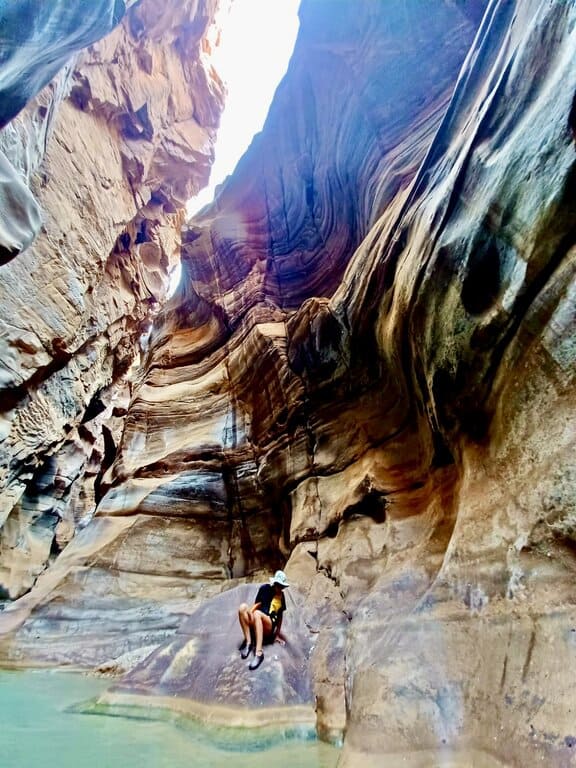
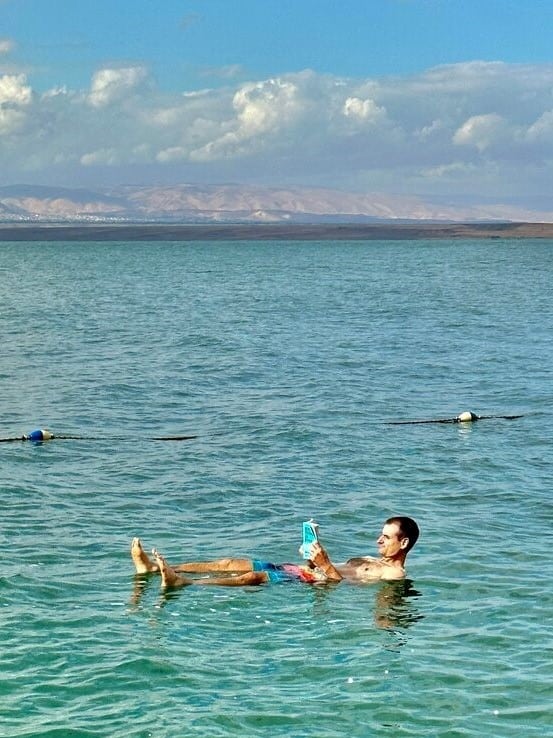
The hike takes you through a narrow slot canyon that is full of water year-round (hence the dry bag). In fact, it’s closed from November 1 – March 31 because the water is too high to safely pass in the winter. In the other months you might have to wade through water up to your chest to complete the hike. Make no mistake, you will get wet doing this hike.
The hike is not long, only 1.5 km each way. But you’re obviously walking through water so it still takes 2-3 hours. You’ll be back to your resort in time for lunch if you’re hungry again.
Spend the rest of the day relaxing along the Dead Sea. If you didn’t float yesterday, be sure to do it today. It’s a once in a lifetime experience that you don’t want to miss out on. The resorts also have amazing pools to chill in after floating. Just be sure to shower first so you don’t track that salty water everywhere!
Enjoy another night along the Dead Sea. The days will be very active from here on out so get your rest!
Day 3: Dead Sea to Petra
It’s about a 3 hour drive from the Dead Sea resort area to Wadi Musa, where the famous ancient archaeological site of Petra is located. The drive takes you along the Dead Sea Highway and then into some red sandstone mountains, through many small villages, and eventually to Wadi Musa.
Once you pass Wadi Mujib you’ll notice that the coast of the Dead Sea becomes a bit more dramatic. Here the coast is not sandy, but salty. Layers of bright white salt form a crusty coastline. It’s unlike anything you’ve probably seen before (well unless you’ve been to places like Death Valley and Atacama, Chile).

There are many public sea access points down here should you wish to take another dip in the sea. Even if you don’t go in, I recommend stopping for photos at one of the following “beaches”:
- Dead Sea Public Beach Spot 1
- Dead Sea Public Beach Spot 2
- Dead Sea Public Beach Spot 3
- Dead Sea Public Beach Spot 4
Onward to Petra
Depending on how fast you’re moving you’ll arrive in Wadi Musa sometime in the afternoon. You want to get there by 4:30 at the latest because today you will want to get your ticket for Petra.
Petra tickets come in 1, 2, or 3 day passes. The price of your Jordan Pass depends on which you choose, so you have to choose ahead of time. With a 1 day ticket, Jordan Pass is 70 JOD. With a 2 day ticket it’s 75 JOD, and for a 3 day ticket it’s 80 JOD. I highly recommend the 3 day pass for this itinerary.
Show your Jordan Pass at the ticket office and they’ll give you your Petra entrance ticket. Do not lose the ticket! This is now the first day of your 3 day pass. If you have time, you can walk through the siq to the Treasury, the main landmark in Petra. It’s about a 1 mile walk, nearly completely flat.
If you’d rather save that for tomorrow, head to your hotel and enjoy a night in Wadi Musa. Note that nearly all restaurants are dry in Wadi Musa, so if you want alcohol you’ll have to go to the western hotels like the Movenpick. For more information about drinking in Jordan you can refer to my specific article about alcohol in Jordan.
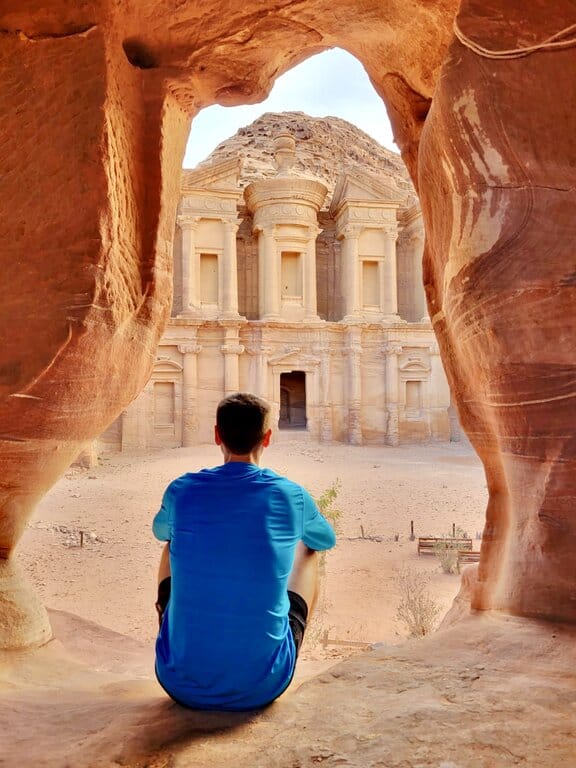
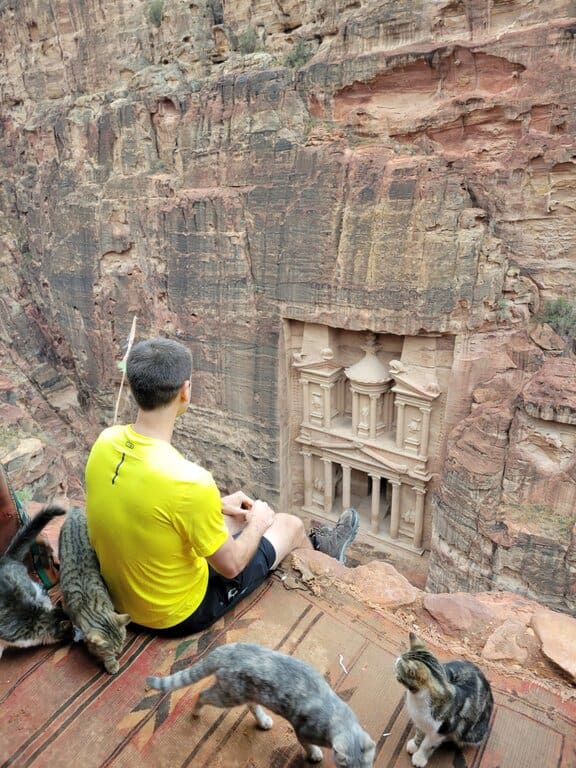
Your last goal for today is to secure a ride to the back entrance of Petra for tomorrow morning. Refer to my detailed guide linked here for how to get to the back entrance of Petra. I highly recommend you read the entire thing (it’s long), but basically, inquire at your hotel or with local taxi drivers for someone to drop you off at the back entrance before sunrise. Trust me on this one!
Where to stay in Wadi Musa
Budget: Plaza de Petra
Mid Range: Esperanza Petra
High End: Petra Marriott Hotel
Optional stops for Day 3
If you leave the Dead Sea early and don’t want to make any more stops around the sea, you might have time to check out the Dana Biosphere Reserve and fit in a short hike. The Dana Biosphere Reserve is basically just a mountain park with some gorgeous sandstone mountains.
You’ll find a number of hiking trails in the park. It’s also the start of a multi-day trek through the mountains to Petra. The trek takes 5 days and needs to be booked ahead of time.
Day 4: Petra
Today is a big day. You will be exhausted by the time the sun sets, so be sure to pack enough food for energy in your daypack. Assuming you’ve arranged transport to the back entrance of Petra, you’ll be up long before sunrise to catch your ride.
Your driver will follow some 4×4 dirt roads and drop you off by a checkpoint. Early in the morning there is usually nobody working but show your Petra ticket if there is. It’s about a 45 minute hike from here to the Monastery, the second most famous landmark in Petra.
The reason you start early at the back entrance is to be the first one at the Monastery. I will let the pictures below speak for themselves. Having this iconic place to yourself is simply amazing.
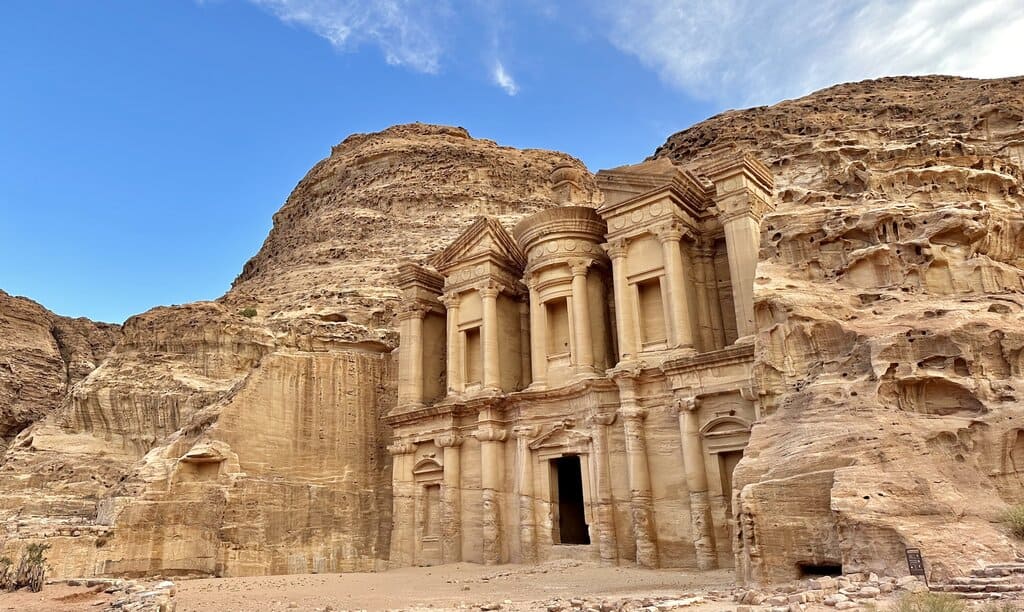
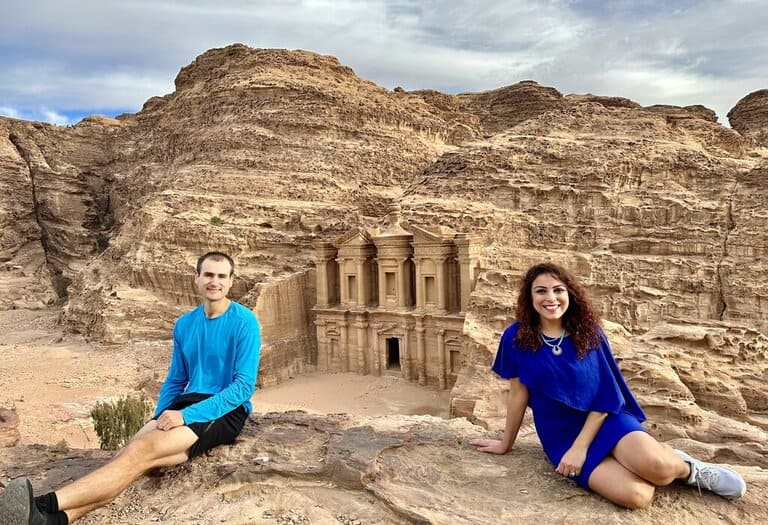
From here you’ll spend the day exploring the ancient Nabatean city of Petra. The Nabateans are the indigenous people of the region and they carved amazing cave structures into the sandstone mountains. After Petra was abandoned in the 4th century, various Bedouin traders moved into the caves over the next 1500 years. They lived in these caves literally up until the 1990s when the Jordanian government forced them into apartments in the city.
Petra is one of the New Seven Wonders of the World and as you explore you will understand why. There is so much to see and do in Petra. I go into great detail about Petra in my post about getting to the back entrance so refer to that for more info about what to do in Petra.
By the end of the day you’ll be completely exhausted. If it’s a Monday, Tuesday, or Thursday night, you will also have the opportunity to experience Petra at Night. On these nights, the park sells separate tickets at 17 JOD per person for the Petra at Night show. You must purchase these tickets at the main ticket office before 5:00.
It’s basically a light show on the Treasury with some local music. If you’re too tired it’s really not worth it. But it’s an experience for sure.
Day 5: Petra to Wadi Rum
It’s about a 2 hour drive from Wadi Musa to the sandy desert of Wadi Rum. So you’ll have time to wake up early and experience Petra before the crowds set in.
Today you’ll enter through the main gate in hopes of being one of the first people to the Treasury. You absolutely will not have it to yourself (like you hopefully had the Monastery yesterday) but you should be able to get in a few good photos without other people around.
The gates open at 6 AM so be there when they open. Depending on how much time you want to spend in Petra today you can check out some other viewpoints or do some additional hiking. When you’re satisfied that your time in Petra has been satisfactory, check out of your hotel and hit the road to Wadi Rum.
The Wadi Rum Protected Area
Wadi Rum is one of the most unique landscapes on earth. In fact, many people compare it to Mars, since it’s the closest thing we have on this planet to what the photos of Mars have shown. Red sand everywhere. Giant red mountains protruding out of the sand. It’s seriously a site to behold.
Depending on where you’re staying it can be very easy or quite difficult to get to your accommodation in Wadi Rum. Some places you can drive a normal car to. Others you need to park in the village and get a ride across the sand to. In the case of the latter, your accommodation will arrange everything for you.
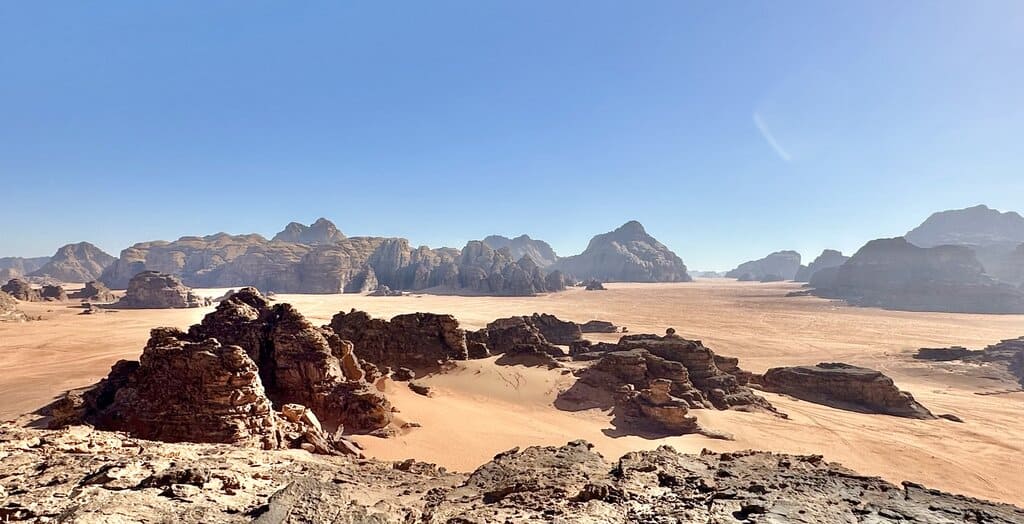
Spend the rest of the afternoon and evening enjoying the desert views and catching an epic desert sunset. Dinner will be organized by your accommodation. There are no restaurants you can just go to. The “camps” – as they call them in Wadi Rum – are spread out all over the desert.
Where to stay in Wadi Rum
Accommodations in Wadi Rum are different from what you might be used to. It’s a big desert with camps everywhere. These camps have everything from super cheap traditional Bedouin tents to ultra luxury bubble “Martian” domes.
The camp you stay at will provide all your food as well as book any excursions for you. There are no restaurants or supermarkets. You won’t leave your camp other than for the excursions.
The budget tents will not have air conditioning. It cools down in the desert at night, but it can still be awfully hot. They are not really tents, though, in the western sense of the word. They are more like flat-roofed teepees with simple beds for sleeping.
The “Martian” domes are usually air conditioned and much more spacious. Check out the view from our Martian dome in the photo below! And if you’re wondering where to stay in Wadi Rum, be sure to check out my guide to the best bubble tent hotels in Wadi Rum.

Where to stay in Wadi Rum
Budget: Flowers Rum Camp
Mid Range: Hasan Zawaideh Camp
High End: Wadi Rum UFO Luxhotel
Day 6: Wadi Rum Protected Area
Today you’ll spend the day discovering the majestic Wadi Rum desert. There are various excursions you can take in the desert. Your camp will walk you through all the different options when you check in. Be sure to book the day before to ensure you have a spot.
Some of the options for exploring Wadi Rum are a 4×4 Jeep ride, sandboarding, camel riding, and hiking. By far the most popular activity – and my recommendation – is the 4×4 Jeep tour. There are half day and full day options, depending on how much you want to pay. The half day option (4 hours) averages about $90 USD per person and the full day (6 hours) runs about $115 USD. Prices vary depending on your camp, though, so don’t quote me on that.
The Jeep tour will take you cruising across the red desert sand in a customized pickup truck. You’ll be outside in the cab as your tour guide drives, feeling the wind on your face as you take in the beauty of Wadi Rum.
There are various stops you’ll make to see some of the main sites and most beautiful views in Wadi Rum. You’ll also stop at local Bedouin tents for tea and snacks, and have time for a few short hikes up some of the red rocks.
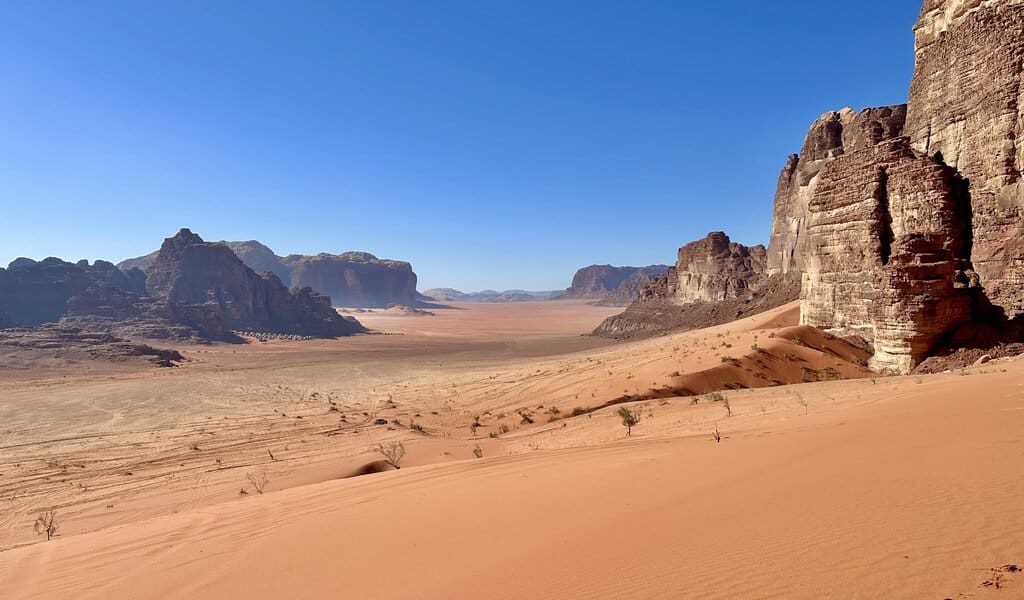
A full explanation of the Jeep tour is beyond the scope of this Jordan road trip itinerary post, but as I’m sure you can guess by now, the desert is absolutely gorgeous. It’s one of the most amazing things you’ll ever see in your life.
If you did the half day tour, you’ll have time in the afternoon to either relax at your camp or set off on a hike. There are giant rock mountains protruding out from the sandy floor everywhere and they are all easy to climb up for anyone with moderate bouldering experience.
Enjoy your final dinner in Wadi Rum and take it easy at the camp. Drink tea with the locals (no alcohol in Wadi Rum) and dance to the traditional music. Tomorrow it’s back to the city.
Day 7: Wadi Rum to Amman
While Wadi Rum is amazing, you’ll want to get going pretty early today so that you have ample time to explore Amman. It’s about a 4 hour drive from Wadi Rum to Amman and ideally you’ll want to get to your hotel around 12:00.
If the hotel will let you check in early, great. If not, drop your bags off because it’s time to explore one of the oldest cities in the world.
Amman is the bustling capital of Jordan. The city center is walkable, but quite hilly. Depending on where you’re staying, you might want to take an Uber into the city center. Uber is super cheap in Amman and a reliable and comfortable way to get around.
Exploring Amman
You don’t have a lot of time in Amman so you’ll want to start with the city’s main attraction, the Amman Citadel. The Citadel is the ancient Roman city atop a large hill. Most of the ancient city did not endure the last 2000 years, but the ruins that do remain are well-preserved and fascinating to learn about. Make sure to bring your Jordan Pass for entry to the Citadel.
Down the hill from the Citadel is the ancient Roman Theater of Amman. It’s only 3 JOD for entrance ($4.20 USD) so it’s worth a quick stop to sit in the ancient amphitheater. Though by now you might have had your share of ancient Roman amphitheaters!
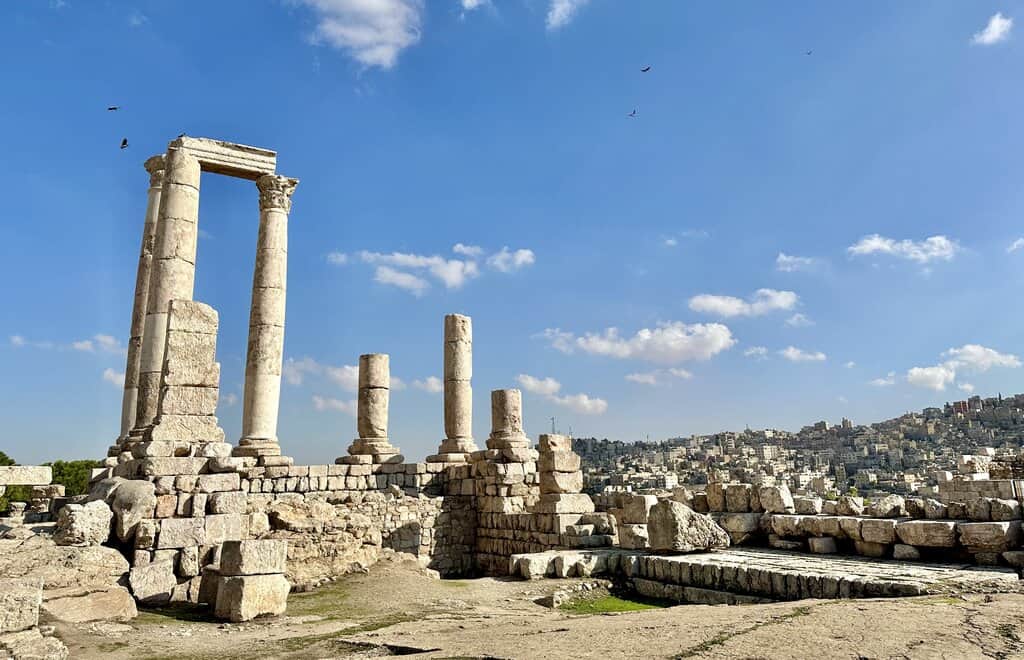
Many people also choose to stop at the Grand Husseini Mosque, which dates back to the seventh century. But it’s really not that remarkable of a building and you won’t be fooled into thinking you’re at the Blue Mosque in Istanbul or the Sheikh Zayed Grand Mosque in Abu Dhabi. Should you feel you have time, it might be worth going inside and checking out.
Lastly, be sure to explore the many streets and alleyways of markets in Amman. These markets are jam packed with fresh produce, nuts and dates, locally stitched clothing, and anything else you can imagine. Load up on some local spices to add some flare to your next meal back home.
Eating in Amman
Here’s where I tell you that throughout most of this trip, the food is really not going to be anything special. Everywhere you’ve been so far is catered to tourists. Food quality is lacking in Wadi Musa and Wadi Rum and even at the Dead Sea. At this point in your adventure you might be thinking that Jordanian food is not all that special.
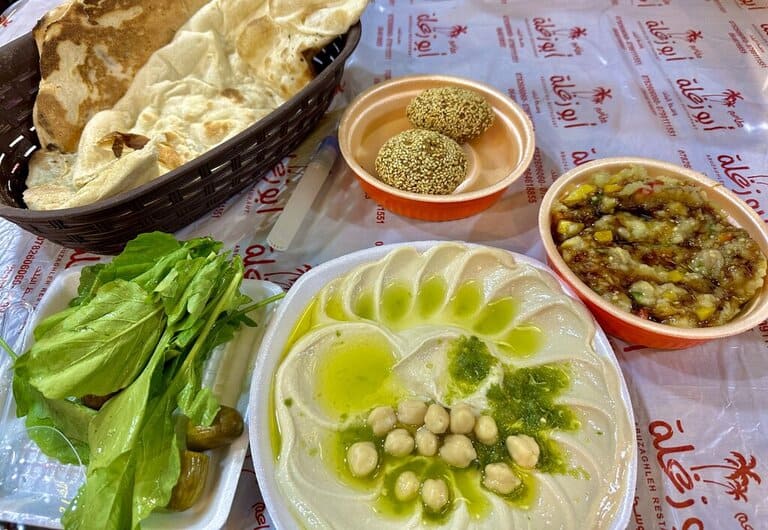
Amman will change your mind though. The city is full of fantastic restaurants and local holes in the wall that are dirt cheap and utterly delicious. Here are a few restaurants to consider. I hope you’re hungry!
- Abu Zaghleh Restaurant Downtown: Super cheap place packed full with locals. Service is mediocre but the food makes up for it.
- Jafra Restaurant & Cafe: A nicer place where you can sit on the balcony overlooking the busy street below.
- Hashem Restaurant Downtown: This is Amman’s most popular restaurant, famous for its falafel. Prepare to wait for a table.
If you have a sweet tooth you’ll be in heaven in Amman. Check out Habibah Sweets for some kunafa, which is sort of a custardy, cheesy, filo-based dessert. You just have to try it. Note that this place gets super busy but there are other sweets places nearby that are just as good and not as crowded.
If you’re desperate for a drink after a few nights in rural Jordan, Amman will satisfy that craving too. While there are not a ton of places that serve alcohol, it’s not too hard to find them. Beer and wine will be listed on the menu if they serve it. One such place that does serve alcohol is Zorba.
Depending on how tired you are and when your flight is, you can spend the night out in Amman, or head back to your hotel.
Where to stay in Amman
Budget: Al Midan Hotel
Mid Range: New MerryLand Hotel
High End: Grand Hyatt Amman
The End of Your Epic Trip to Jordan
What a trip to Jordan it has been! I hope you’ve enjoyed this magical country and go back home and tell your friends all about the warmth of the Jordanian people and the incredible things you saw.

7 Day Jordan Itinerary: FAQs
Is 7 days enough for Jordan?
7 days is enough to see the highlights of Jordan. 9-10 days would give you a slightly more relaxed pace or some additional time in Amman. But you can make do with 7 days.
How many days can I stay in Jordan?
You can stay in Jordan for 30 days on a tourist visa.
How many days do you need in Petra?
It’s best to have at least one full day in Petra to get the most out of your experience. It’s possible to see the main sites in less than a day, but you’ll have to move pretty fast.
What’s the best month to visit Jordan?
The best months to visit Jordan are April, May, September and October. This is solely based on weather and avoids the summer heat and the winter chills.
Can you wear whatever you want in Jordan?
While Jordan is a majority Muslim country, it’s far more open-minded than many others when it comes to clothing. You can wear shorts, tank tops, whatever you want in Jordan and no one will bat an eye.

